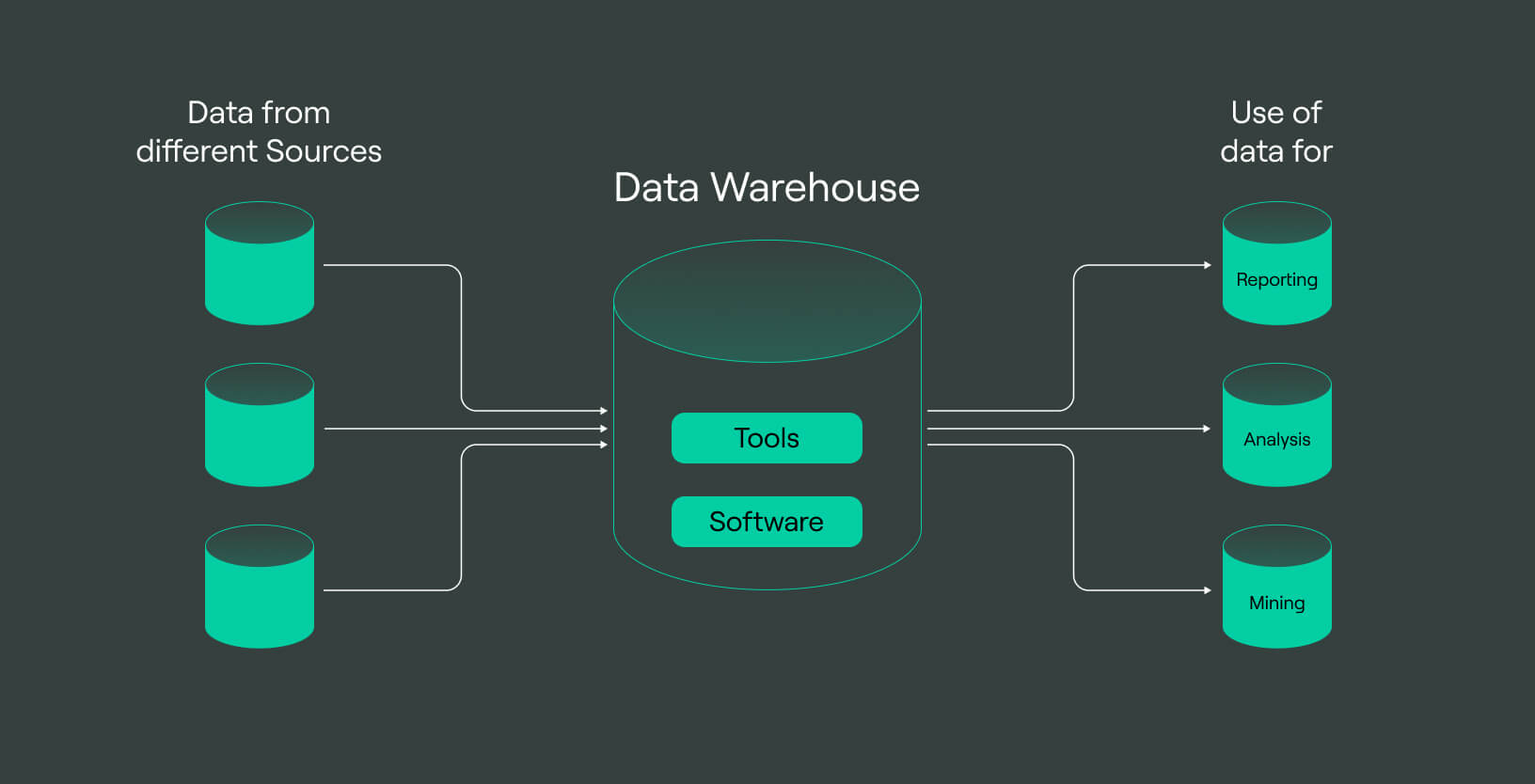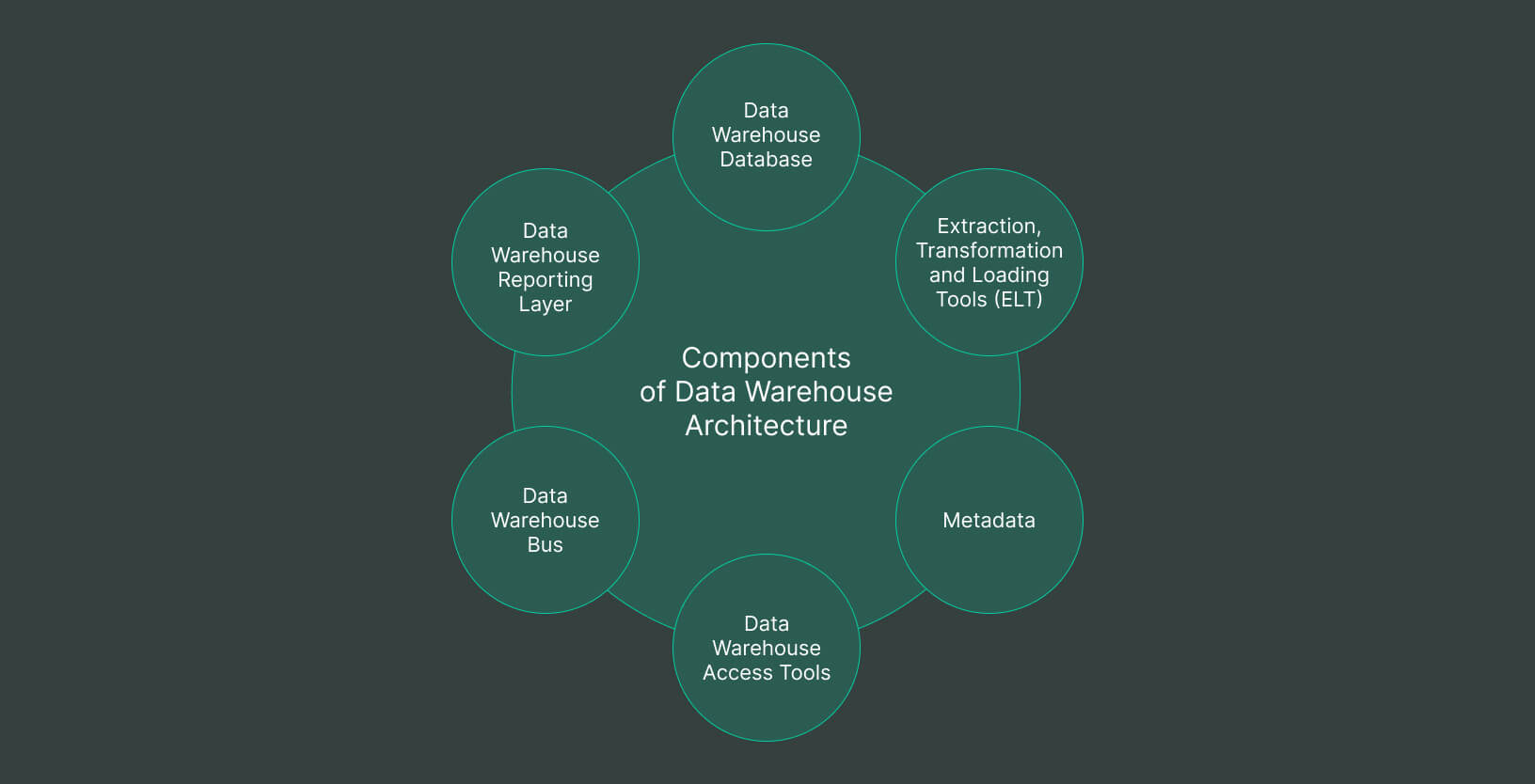
What is data warehouses: Business benefits and key concepts
Data warehouse: What it is, how it works, and why your business needs it
In today’s world, where data reigns supreme, businesses cannot afford to overlook the importance of data warehousing. As companies accumulate vast amounts of data, data warehousing provides a centralized repository to store, process, and analyze all this data.
In this article, we’ll take a deep dive into the world of data warehousing — from what it is and how it works to why it’s crucial for businesses that want to stay ahead of the curve and leverage real-time data to drive growth and profitability.
What is a data warehouse? meaning & definition
What is a data warehouse? A modern data warehouse system is a useful commercial tool for managing and analyzing massive volumes of data. It is used to gather and organize data from multiple sources and is specially developed to help business intelligence operations, including data analysis. A data warehouse’s principal function is to give valuable insights to assist organizations in making informed choices.
They are used for querying and analysis and are built to manage massive volumes of data, especially historical data. These are central repositories that consolidate data from multiple sources into a single place, enabling various departments within a firm to access and analyze each other’s data.
In response to the rising demand for organizations to manage and store data, IBM researchers Barry Devlin and Paul Murphy proposed the notion of a data warehouse in 1988.
As businesses grew more reliant on computer systems to generate and retrieve critical business papers, the necessity for a centralized repository for all of this data became essential.
With well-designed data warehousing systems, businesses can readily access and analyze data from several departments, increasing cooperation and decision-making. For example, a marketing team may leverage data from the sales team to create efficient sales campaigns. To get a pictorial insight into data warehousing, check out this video:
In this article, we’ll talk about:
- What is a data warehouse? meaning & definition
- Key concepts of data warehousing
- What can a data warehouse store?
- Data warehouse architecture: how it is build?
- What are the key components of a data warehouse?
- How does a data warehouse work?
- Who uses a data warehouse?
- What data warehouse is used for? use cases
- How does a data warehouse improve business intelligence?
- Types of data warehouses
- Pros and cons of data warehouses
- Data warehouse, data lake, data mart, data mesh: isn’t it all the same?
- How DoubleCloud helps with a big amount of data?
- Final words

Is data warehouses a databases?
Both data warehouses and databases are independent systems that store and manage data in various ways. A database maintains current data needed to run an application, while data warehouses save current and historical data from one or more systems in a pre-defined and fixed structure for data analysis.
Companies generally utilize data warehouses for data mining, which involves looking for patterns in data to optimize business operations. Businesses may increase cooperation across departments by making it easy to access each other’s data by establishing a data warehousing system.
Key concepts of data warehouses
As the value of data grows, it is becoming evident that data warehousing is an essential tool for businesses of all sizes and sectors seeking to store and analyze their data properly. These are some major data warehousing concepts:
Data sources and integration
Data sources and integration are pivotal in data warehousing. It involves gathering data from diverse sources, like databases, data warehouse applications, and external data sources, and merging them into a unified view. In most organizations, data is stored in disparate formats and structures, posing difficulties in accessing and analyzing it. This is where data warehousing comes into play. Businesses can access and analyze data efficiently and consistently by consolidating data in a single location.
Data integration plays a crucial role in data warehousing, and it involves blending data from various sources into a standardized format. This is done through an ETL process, which extracts data from different sources, transforms it into a uniform format, and loads it into the data warehouse.
Data storage
A warehouse data is a central repository for structured and semi-structured data used for reporting and analysis. It is a one-stop shop where data is gathered regularly from several different sources such as relational databases, transactional systems, external sources, etc.
This recorded data is processed and structured to allow stakeholders such as business analysts and decision-makers to analyze it. This personnel may then use the data insights to make educated choices that affect the organization’s performance.
Data backup is an essential component of data storage in data warehousing. Businesses must have a well-defined backup and recovery strategy to restore their data during a catastrophe.
Data transformation and loading
Data transformation is the process of manipulating and cleaning data from various sources to ensure consistency, accuracy, and relevancy. It involves extracting data from multiple sources, filtering out unwanted information, converting it to a standard format, and finally loading it into a data warehouse.
The primary aim is to provide clean and accurate data for analysis and decision-making by various stakeholders. Loading, on the other hand, refers to moving the transformed data from source systems to the target database or warehouse.
The ETL (Extract-Transform-Load) process transforms and loads data in data warehousing. This process involves extracting data from source systems, transforming it into a consistent format, and loading it into the target system.
Loading data can be done in real-time or batch mode, depending on the organization’s requirements. Batch loading loads large volumes of historical or transactional data records simultaneously, while real-time loading is used for continuous and frequent small amounts of data.
Data querying and analysis
Data querying and analysis are essential components of data warehousing, allowing organizations to extract valuable insights and make informed decisions. By using querying tools and analytical techniques, businesses can delve deep into their data, identifying patterns, trends, and relationships that might otherwise go unnoticed.
A data warehouse, as the central repository for an organization’s data, collects information from various sources and provides a unified view of the organization’s operations. Querying retrieves certain data that meets specific criteria, typically using Structured Query Language (SQL) or other data warehouse or query tools. Analysis involves exploring and interpreting the data to identify significant trends and insights.
The importance of data querying and analysis cannot be overstated. By leveraging the power of data warehousing, businesses can gain a deeper understanding of their customers, market trends, and internal operations. Armed with this information, they can make more informed decisions, improve operational efficiency, and gain a competitive advantage.
Metadata management
Metadata management is critical to helping firms identify and manage their ever-growing data. It is generally data that defines other data and is classified into three types: business metadata, technical metadata, and algorithms for summarization.
Business metadata contains information regarding data ownership, business definitions, and policy changes. Details such as relational database system names, table and column names and sizes, data types, and permitted values are examples of technical metadata. It also includes structural data like main and foreign key characteristics and indexes.
Meanwhile, algorithms of summarization address topics such as dimension algorithms, data granularity, and summarizing and aggregating data.
Metadata management is in charge of gathering all the data required to design, develop, utilize, and analyze the contents of a data warehouse. It is a critical component of any data governance program since it assists companies in better understanding their data assets.
What can a data warehouse store?
A data warehouse can store diverse data types, including; structured, semi-structured, and unstructured data. Structured data follows a particular format, such as tables, while semi-structured and unstructured data are without a specific structure, such as emails, videos, and social media posts.
Data warehousing systems typically store data in a dimensional model optimized for querying and reporting. The dimensional model organizes data into facts and dimensions, with facts representing numerical measurements and dimensions representing the attributes used to categorize or filter the facts. The more data you throw at a problem, the better machine learning works.
An example of data that could be stored is sales data from a retail store. The warehouse would contain sales data from various sources, including point-of-sale (POS) systems, online orders, and other data feeds. The data would be organized into a dimensional model, with facts such as sales revenue, units sold, discounts applied, and dimensions such as date, product, store location, and customer.
Data warehouse architecture: How it is build?
A typical data warehouse architecture fulfills a company’s information needs and goals. Both data warehouses' logical and physical data models are included in the design. Data warehouse architecture designs are classified into three types: single-tier, two-tier, and three-tier.
Data is kept in a more compact dataset in a single-tier design, which helps to eliminate data redundancy and increase data quality. A four-stage data flow separates the physical sources from the data warehouse in the two-tier design. Data integrity is crucial in the warehouse, and the source of the data plays a vital role in guaranteeing data integrity.
The three-tier architecture is the most often utilized design. It is divided into three tiers: the bottom tier, the middle tier, and the top tier. The data warehouse server holds raw data, and it is located on the bottom tier. Back-end tools convert, cleanse, and load data into this layer. The intermediate layer offers multidimensional views of the processed data for analysis. Front-end client tools for querying and reporting comprise the top layer.
Scalability, storage-as-a-service capability, high elasticity on-demand, and secure sharing capabilities are all desirable characteristics of a cloud-optimized data warehouse. Snowflake’s multi-cluster shared-data architecture is built for cloud-based applications and can manage ETL and ELT procedures while providing safe sharing. It replaces standard extract procedures and readily adapts to analytics and other use cases.

What are the key components of a data warehouse?
A data warehouse is an extremely useful tool for evaluating massive amounts of data. It is made up of four basic components, each of which enhances speed and efficiency.They are;
A centralized database: This is the basis of your data warehouse and might be a regular relational or an in-memory database. In-memory databases are gaining popularity because they provide real-time performance at a lower cost.
Data integration: This entails obtaining data from source systems and altering it to meet your analytical requirements. This procedure may incorporate a variety of approaches, including ETL and ELT, as well as real-time data replication and bulk-load processing. Data transformation, quality, and enrichment services are also leveraged to guarantee the data is in the optimum condition for analysis.
Metadata: This relates to information about your data, such as its source, use, and values. There are two sorts of metadata: business metadata, which gives meaning to your data, and technical metadata, which explains how to access the data, where it lives, and its structure.
Data warehouse access tools: These enable people to engage with data. Query and reporting tools, data mining tools, application development tools, and OLAP tools are examples of such tools.
How does a data warehouse Work?
Data warehousing is a game changer when integrating data from diverse sources. Businesses may acquire valuable insights into making educated choices by gathering and combining data from numerous sources.
A data warehouse, for example, may be used by a company to aggregate client information from many sources, such as point-of-sale systems, mailing lists, websites, and comment cards. They may also include sensitive information such as employee compensation details. Businesses may evaluate client behavior and develop better plans to increase sales and profitability by having this information in one location.
A data warehouse must include data mining. It enables firms to look for relevant data patterns in massive amounts of data. Businesses may use data mining techniques to reveal hidden patterns, correlations, and linkages that would be difficult to spot using traditional approaches. This information may then be utilized to develop novel sales and profit-boosting initiatives.
Who uses a data warehouse?
Data warehouses are utilized by businesses of all sizes and in various sectors. Business analysts, data scientists, and other professionals often use them to evaluate extensive data to acquire insights into corporate performance.
They are also utilized by teams in charge of reporting, planning, and making decisions. A data warehouse, for example, is used by Amazon to monitor consumer behavior and enhance its recommendation engine.
Google uses it to evaluate user activity on its search engine and other products. AirOps employs a data warehouse to store and analyze flight operations data from different sources. Several large-scale firms, like Facebook, Yahoo! , eBay, and Twitter, utilize Hadoop to store and analyze enormous amounts of data.
What data warehouse is used for? Use cases
Businesses can utilize the data warehouse to swiftly and effectively examine massive amounts of data without affecting normal operations. Data warehousing use cases include:
Retail company
A retail corporation can utilize this tool to evaluate sales transactions, consumer behavior, inventory levels, and supplier information to spot patterns and manage its supply chain.
Healthcare institute
Healthcare institutions can employ a data warehouse to examine patient information and medical studies to enhance patient outcomes.
Financial organizations
A data warehouse may also be used by a financial institution to monitor market trends and client behavior to make educated investment choices.
How does a data warehouse improve business intelligence?
A data warehouse is a must-have tool for companies who want to acquire meaningful insights from their data. It is a consolidated store for all corporate data and a dependable source of information for analysis and reporting. Businesses can be certain that they are dealing with correct and consistent data when they employ a data warehouse, avoiding the danger of making choices based on inaccurate information.
Data is extracted, converted, and placed into a data warehouse, where it is carefully structured and optimized for querying and analysis. This guarantees that organizations have access to the most recent information, enabling them to make educated choices based on real-time insights.
One of the most important advantages of data warehouses is tha capacity to evaluate historical data. Businesses may generate accurate forecasts about future performance by analyzing historical trends and patterns. As a result, businesses can make more strategic choices about everything from product development to marketing and resource allocation.
Types of data warehouse
There are different types of data warehouses. Businesses must consider size, industry, and unique data management requirements when choosing a data warehouse solution. After reviewing these factors, they can select the best data warehouse option that matches their needs, and these are:
Enterprise data warehouse
Enterprise data warehousing (EDW) is a vital part of contemporary data management. An EDW is simply a huge database or set of operational databases intended to store and manage historical business data from multiple sources and applications. An EDW helps firms to acquire a complete perspective of company performance and analyze massive amounts of data quickly and effectively by providing a consolidated repository for this information.
An EDW may be kept on-premise data warehouses or in the cloud, and it includes vital information about customers, sales, inventory, suppliers, and more. By harnessing this data, organizations may make educated choices that benefit their bottom line.
Operational data store
An operational data store (ODS) is a data warehouse serving as a central repository for all the most recent data from various online transactional processing systems. Its objective is to give a real-time picture of an organization’s present situation for operational reporting and decision-making.
This may give you a better knowledge of what’s happening inside your business by processing data from different sources. It’s ideal for maintaining inventory levels, tracking client orders, managing supply chain operations, and other tasks that need current data.
So, an ODS is a must-have if you want to stay on top of your organization’s performance and make educated choices.
Data mart
Data marts are centralized databases that cater to specific business lines or functional areas inside a company. This data warehouse stores summary data gathered for analysis and reporting.
Data marts are tailored to the requirements of specific departments or teams, such as sales, marketing, or finance. Their major purpose is to give rapid access to the information required for sound decision-making.
Data marts are built for query and analysis rather than transaction processing. They exclusively include data relevant to a certain department, making them more manageable and simpler to administer than more extensive data warehouses. You can receive the information you need, when needed, using data marts rather than trawling through large volumes of data that may or may not be relevant to your department.
Virtual data warehouse
Virtual data warehouses may be accessed simultaneously, giving the impression that they are data stored in the same data location. They function similarly to an independent compute resource that may be used at any moment for SQL execution and Data Manipulation Language (DML) and then turned off when no longer required.
They benefit cloud-based systems, offering a flexible and scalable option for storing and analyzing massive amounts of data from diverse sources. They are intended to assist enterprises in managing and storing data without costly hardware or software infrastructure.
Cloud data warehouse
Cloud data warehouses are databases hosted in the public cloud as a managed service and are specially built for scalable business intelligence (BI) and analytics. Cloud data warehouses gather and store data from numerous sources using the cloud provider’s computational power and storage space.
A cloud data warehouse is an excellent choice for businesses that need to store and analyze large amounts of structured and unstructured data from various sources. Cloud data warehouses offer a flexible and scalable option for large data management. This enables enterprises to outsource data storage management to cloud providers that must satisfy service-level agreements, resulting in operational savings.
Pros and cons of data warehouse
There are several pros and cons that organizations should consider before implementing a data warehouse, and these are:
|
Advantages |
Disadvantages |
|
Provides a centralized location for storing and managing data. |
It can be expensive to implement and maintain. |
|
Can quickly and easily access data for reporting and analysis. |
It requires a significant amount of time and effort to design and implement. |
|
Improves data quality by ensuring consistency across multiple sources. |
This can lead to data silos if not properly integrated with other systems. |
|
Supports decision-making by providing accurate, timely, and relevant data. |
It may require specialized skills and expertise to manage and maintain. |
|
Increases efficiency by reducing the need for redundant data entry and processing. |
It may require additional investment in hardware and software to scale up. |
|
Facilitates collaboration by providing a shared view of data across the organization. |
Integrating data from different sources with different formats can be a challenge. |
Data warehouse, data lake, data mart, data mesh: Isn’t it all the same?
It’s easy to assume that they’re all the same, right? But, when it comes to data management systems, they each serve a distinct role.
A data warehouse is a central repository for structured data that has been cleansed and converted for use in business intelligence and analytics. It is designed for querying and reporting and serves as the organization’s single source of truth.
On the other hand, a data lake is a location where raw, unstructured data that does not fit neatly into a data warehouse may be stored. The data is saved in its original format, which makes it more versatile and usable for further study.
Data marts are data warehouse subsets designed for certain departments or business units. They are intended to give a more tailored view of data to consumers who only need certain information.
How DoubleCloud helps with a big amount of data?
DoubleCloud is an amazing platform for organizations looking to scale up their big data processing capabilities. With its cutting-edge architecture, DoubleCloud can provide sub-second speeds and lightning-fast data processing, giving businesses an edge in today’s fast-paced world.
One of the best features of DoubleCloud is its ability to help organizations compare what they already know about their data with its Managed Clickhouse service. This is incredibly useful for identifying patterns, trends, and insights that might otherwise be hidden.
Another great feature of DoubleCloud is that it offers visualization of data warehouse solutions and supports modern data stacks. This makes it easy for organizations to get the most out of their data and make informed decisions.
Perhaps one of the best features of DoubleCloud is that it is in public preview and offers analytics support with no vendor lock-in. This means companies can benefit from advanced business analytics without being tied to a single vendor. Plus, with decreased costs and great support for scaling, updates, backups, and more, DoubleCloud is an all-in-one solution for big data processing.
Final words
Data warehouses are critical components of contemporary business intelligence because they serve as a consolidated store for data that can be quickly accessed, analyzed, and translated into actionable insights. Organizations may utilize data warehouses to make better choices, increase efficiency, and remain competitive in today’s data-driven business climate.
They are intended to assist online analytical processing (OLAP), which allows enormous datasets to be analyzed to uncover patterns, trends, and insights. They are designed for querying and reporting, giving business users real-time data access and analysis. Extract, Transform, and Load (ETL) is a procedure used to transfer data from numerous sources and change it into a consistent format before putting it into the warehouse.
It gathers information from many sources and consolidates it into a single repository for decision-making. Employing a data warehouse provides better data quality, quicker query response times, enhanced decision-making, higher productivity, and cheaper expenses.
Frequently asked questions (FAQ)
How ETL works in data warehouse?
How ETL works in data warehouse?
ETL (Extract, Transform, Load) is a process used to extract data from various sources, transform it into a format that can be loaded into the data warehouse, and then load it into the warehouse.
This process involves several steps, including data profiling, data cleansing, data mapping, and data transformation.
What are the key requirements of data warehouse?
What are the key requirements of data warehouse?
What are the main functions of data warehouse?
What are the main functions of data warehouse?
How can I ensure the security of my data in a data warehouse?
How can I ensure the security of my data in a data warehouse?
What are some popular data warehouse platforms available on the market?
What are some popular data warehouse platforms available on the market?
Start your trial today



